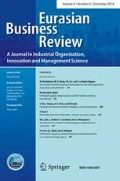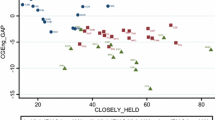Abstract
The aim of this paper is to analyse the effects of national culture and formal institutions on corporate risk-taking. By applying panel data techniques for a sample of large quoted firms from 35 countries over the period of 2007–2014, we document that national culture proxied by Hofstede’s dimensions (power distance, masculinity, individualism, uncertainty avoidance and long-term orientation) influence corporate risk-taking. We also observe that the characteristics and quality of formal institutions in a country can create an environment that promotes risk-taking when corruption perception and financial freedom levels are high. Finally, cultural heterogeneity among shareholders matters for corporate risk-taking, what may help to implement better corporate governance practises. Our research contributes to the existing literature providing further evidence on the direct and indirect effects of national culture on corporate decision-making.



Similar content being viewed by others
Notes
From an agency perspective, type II issues refer to the possible conflict of interest between major and minority shareholders, in companies where ownership structure is highly concentrated (Díez-Esteban et al. 2013).
Karolyi (2016) reports over 92,000 citations of Hofstede’s work on these cultural dimensions from the Financial Times’ 45 journals (according to the Web of Knowledge) over the period 1980–2015, and Aggarwal et al. (2016) note that Hofstede’s work is the earliest and most widely cited among databases on national culture.
Although the analysis of the monitoring role of other reference shareholders is not one of our study focus, we have included a variable (MONITOR) in the empirical model to test the existence of that role in our sample.
Obviously, the influence of other reference shareholders in the decisions of the main shareholder will be conditioned by the power of the latter or, in other words, by their level of participation in the property. This issue has already been analyzed by Konishi and Yasuda (2004).
We calculate the shareholder returns through the formula Ri = (Pt − Pi)/Pi, Pt being the share price at the end of the day and Pi the initial price. If a share was not listed on any given day, we exclude the data from that day to calculate risk.
We consider reference shareholder that owner who owns more than 5% of the capital, as this will allow him to influence the board of directors, appoint managers and intervene in key strategic decisions. Some databases such as Thomson Financial, Marketguide and WorldVest also make use of this ratio to identify the reference shareholders.
This index measures the effectiveness of the monitoring role: PP5 = (P2 + P3 + P4 + P5)/P1, being Pi the proportion of shares owned by each of the first five reference shareholders
References
Acharya, V., Amihud, Y., & Litov, L. (2011). Creditor rights and corporate risk-taking. Journal of Financial Economics, 102(1), 150–166.
Aggarwal, R., Faccio, M., Guedhami, O., & Kwok, C. C. Y. (2016). Culture and finance: An introduction. Journal of Corporate Finance, 41, 466–474.
Alesina, A., & Giuliano, P. (2015). Culture and institutions. Institute for the Study of Labor. Discussion paper no. 9246.
Arellano, M., & Bond, S. (1991). Some tests of specification for panel data: Monte Carlo evidence and an application to employment equations. Review of Economic Studies, 58(194), 277–297.
Arellano, M., & Bover, O. (1990). La econometría de datos de panel. Investigaciones Económicas., 14(1), 3–45.
Attig, N., El Ghoul, S., & Guedhami, O. (2009). Do multiple large shareholders play a corporate governance role? Evidence from East Asia. Journal of Financial Research, 32(4), 395–422.
Attig, N., Guedhami, O., & Mishra, D. (2008). Multiple large shareholders, control contests, and implied cost of equity. Journal of Corporate Finance, 14, 721–737.
Bennedsen, M., & Nielsen, K. M. (2010). Incentive and entrenchment effects in European ownership. Journal of Banking & Finance, 34, 2.212–2.229.
Bilgin, M. H., Gozgor, G., & Lau, M. C. K. (2017). Institutions and gravity model: The role of political economy and corporate governance. Eurasian Business Review, 7(3), 421–436.
Blundell, R., & Bond, S. (2000). GMM estimation with persistent panel data: An application to production functions. Econometric Reviews, 19(3), 321–340.
Blundell, R., Bond, S., & Windmeijer, F. (2000). Estimation in dynamic panel data models: Improving on the performance of the standard GMM estimator. In T. Baltagi, B. Fomby, & B. Carter Hill (Eds.), Nonstationary panels, panel cointegration, and dynamic panels (pp. 53–92). Bingley: Emerald.
Bond, S. (2002). Dynamic panel data models: a guide to micro data methods and practice. Working paper 9/02, The Institute for Fiscal Studies.
Boubakri, N., & Saffar, W. (2016). Culture and externally financed firm growth. Journal of Corporate Finance, 41, 502–520.
Branson, D. M. (2001). The very uncertain prospect of global convergence in corporate governance. Cornell International Law Journal, 34(2), 321–362.
Bruno, V., & Shong Shing, H. (2014). Globalization of corporate risk-taking. Journal of International Business Studies., 45, 800–820.
Chortareas, G. E., Girardone, C., & Ventouri, A. (2013). Financial freedom and bank efficiency: Evidence from the European Union. Journal of Banking & Finance, 37(4), 1223–1231.
De Haan, J., & Sturm, J. E. (2000). On the relationship between economic freedom and economic growth. European Journal of Political Economy, 16(2), 215–241.
DeYoung, R., Peng, E., & Yan, M. (2013). Executive compensation and business policy choices at U.S. commercial banks. Journal of Financial and Quantitative Analysis, 48(1), 165–196.
Díez-Esteban, J. M., García-Gómez, C. D., & López-Iturriaga, F. J. (2013). International evidence about the influence of large shareholders on corporate risk taking. Spanish Journal of Finance and Accounting, 13(31), 126–144.
Fernandez, R. (2008). Culture and economics. In: S. Durlauf, & L.E. Blume (Eds.), The new Palgrave dictionary of economics (2nd edn.). Palgrave Macmillan.
Fuentelsaz, L., González, C., Maícas, J. P., & Montero, J. (2015). How different formal institutions affect opportunity and necessity entrepreneurship. Business Research Quarterly, 18(4), 246–258.
Greif, A. (2006). Institutions and the path to the modern economy: Lessons from Medieval trade. Cambridge: Cambridge University Press.
Griffin, D.W., Guedhami, O., Kwok, C.C.Y., Li, K., & Shao, L. (2017). National culture and the value implication of corporate governance. https://ssrn.com/abstract=2400078. Accessed 3 May 17.
Hofstede, G. H. (1980). Culture’s consequences: International differences in work-related values. Thousand Oaks: SAGE Publications.
Hofstede, G. H. (2001). Culture’s consequences: Comparing values, behaviors, institutions, and organizations across nations (2nd ed.). Thousand Oaks: SAGE Publications.
Huang, B., Wald, J., & Martell, R. (2013). Financial market liberalization and the pricing of idiosyncratic risk. Emerging Markets Review., 17, 44–59.
Ignatowski, M., & Korte, J. (2014). Wishful thinking or effective threat? Tightening bank resolution regimes and bank risk-taking. Journal of Financial Stability, 15, 264–281.
Jensen, M., & Meckling, W. (1976). Theory of the firm: Managerial behaviour, agency costs and ownership structure. Journal of Financial Economics, 3(4), 305–360.
John, K., Litov, L., & Yeung, B. (2008). Corporate governance and risk-taking. Journal of Finance, 63(4), 1679–1728.
Karolyi, G. A. (2016). The gravity of culture for finance. Journal of Corporate Finance, 41, 610–625.
Khanna, T., Kogan, J., & Palepu, K. (2006). Globalization and similarities in corporate governance: A cross-country analysis. The Review of Economics and Statistics, 88(1), 69–90.
Konishi, M., & Yasuda, Y. (2004). Factors affecting bank risk-taking: Evidence from Japan. Journal of Banking & Finance, 28(1), 215–232.
Konjin, S. J. J., Kräussl, R., & Lucas, A. (2011). Blockholder dispersion and firm value. Journal of Corporate Finance, 17, 1330–1339.
Kubicek, A., Bhanugopan, R., & Fish, A. (2013). Perceiving safety and risk in culturally diverse organizations: Toward a conceptual model. Risk Management, 15(3), 199–223.
Kwok, C. C. Y., & Tadesse, S. (2006). National culture and financial systems. Journal of International Business Studies, 37, 227–247.
La Porta, R., López de Silanes, F., & Shleifer, A. (1999). Corporate ownership around the world. Journal of Finance, 54(2), 471–517.
La Porta, R., López de Silanes, F., Shleifer, A., & Vishny, R. W. (1997). Legal determinants of external finance. Journal of Finance, 52(3), 1131–1150.
La Porta, R., López de Silanes, F., Shleifer, A., & Vishny, R. W. (1998). Law and finance. Journal of Political Economy, 106(6), 1113–1155.
La Porta, R., López de Silanes, F., Shleifer, A., & Vishny, R. W. (2000). Investor protection and corporate governance. Journal of Financial Economics, 58(1–2), 3–27.
La Porta, R., López de Silanes, F., Shleifer, A., & Vishny, R. W. (2002). Investor protection and corporate valuation. Journal of Finance, 57(3), 1147–1170.
Laeven, L., & Levine, R. (2008). Complex ownership structures and corporate valuations. Review of Financial Studies, 21(2), 579–604.
Lester, S. (2015). Rethinking the international investment law system. Journal of World Trade., 49(2), 211–222.
Li, K., Griffin, D. W., Yue, H., & Zhao, L. (2013). How does culture influence corporate risk-taking? Journal of Corporate Finance, 23, 1–22.
Licht, A. N., Goldschmidt, C., & Schwartz, S. (2005). Culture, law, and corporate governance. International Review of Law and Economics, 25, 229–255.
Licht, A. M., Goldschmidt, C., & Schwartz, S. H. (2007). Culture rules: The foundations of the rule of law and other norms of governance. Journal of Comparative Economics., 35, 659–688.
Maury, B., & Pajuste, A. (2005). Multiple large shareholders and firm value. Journal of Banking and Finance, 29(7), 1813–1834.
Morck, R., Wolfenzon, D., & Yeung, B. (2005). Corporate governance, economic entrenchment, and growth. Journal of Economic Literature, 43(3), 655–720.
Morck, R.; Yeung, B., & Yu, W. (2000). The information content of stock markets: Why do emerging markets have synchronous stock price movements? Journal of Financial Economics, 58(1–2), 215–260.
Nash, R., & Patel, A. (2014). The impact of national culture on corporate financial decisions. Wake Forest Law Review, 48, 697–720.
Nguyen, P. (2011). Corporate governance and risk taking: Evidence from Japanese firms. Pacific-Basin Finance Journal, 19(3), 278–297.
North, D. (1990). Institutions, institutional change, and economic performance. Cambridge: Cambridge University Press.
Podobnik, B., Shao, J., Njavro, D., Ivanov, P. C., & Stanley, H. E. (2008). Influence of corruption on economic growth rate and foreign investment. The European Physical Journal B, 63(4), 547–550.
Ruiz, M. V., & Santana, D. J. (2011). Dominant institutional owners and firm value. Journal of Banking & Finance, 35, 118–129.
Sanchirico, C. W. (2015). As American as Apple Inc.: International tax and ownership nationality. Tax Law Review, 68, 207–274.
Shao, J., Ivanov, P. C., Podobnik, B., & Stanley, H. E. (2007). Quantitative relations between corruption and economic factors. The European Physical Journal B, 56(2), 157–166.
Villalonga, B., & Amit, R. (2006). How do family ownership, control, and management affect firm value? Journal of Financial Economics, 80(2), 385–417.
Yoshikawa, T., & Rasheed, A. A. (2009). Convergence of corporate governance: Critical review and future directions. Corporate Governance: An International Review, 17(3), 388–404.
Zheng, X., El Ghoul, S., Guedhami, O., & Kwok, C. C. Y. (2013). Collectivism and corruption in bank lending. Journal of International Business Studies, 44, 363–390.
Acknowledgements
This research has been financed by Portuguese Public Funds through FCT (Fundação para a Ciência e a Tecnologia) in the framework of the project UID/ECO/04105/2013. The authors are grateful to participants on the 23rd EBES Conference for their comments on previous versions. All the remaining errors are our responsibility.
Author information
Authors and Affiliations
Corresponding author
Rights and permissions
About this article
Cite this article
Díez-Esteban, J.M., Farinha, J.B. & García-Gómez, C.D. How does national culture affect corporate risk-taking?. Eurasian Bus Rev 9, 49–68 (2019). https://doi.org/10.1007/s40821-018-0105-0
Received:
Revised:
Accepted:
Published:
Issue Date:
DOI: https://doi.org/10.1007/s40821-018-0105-0




